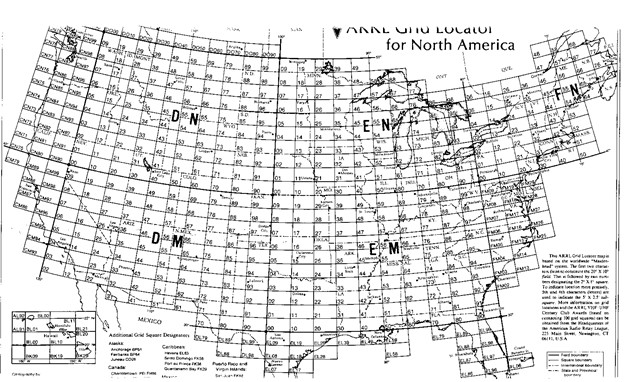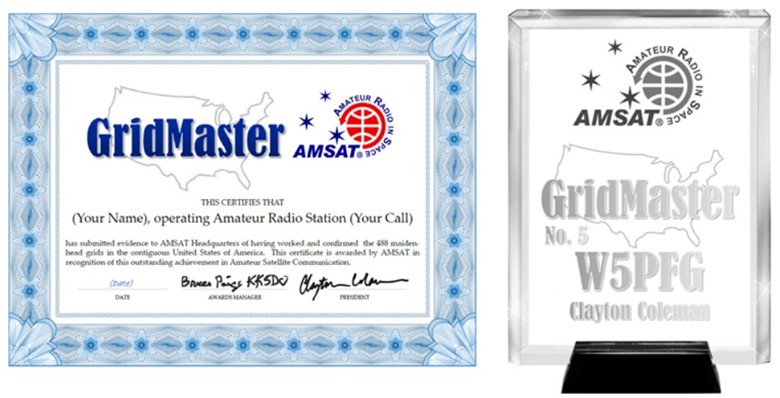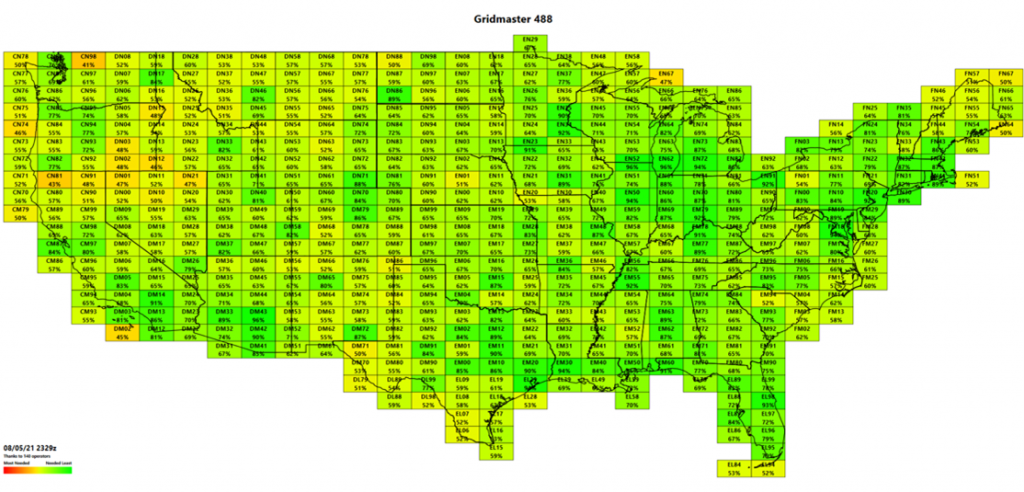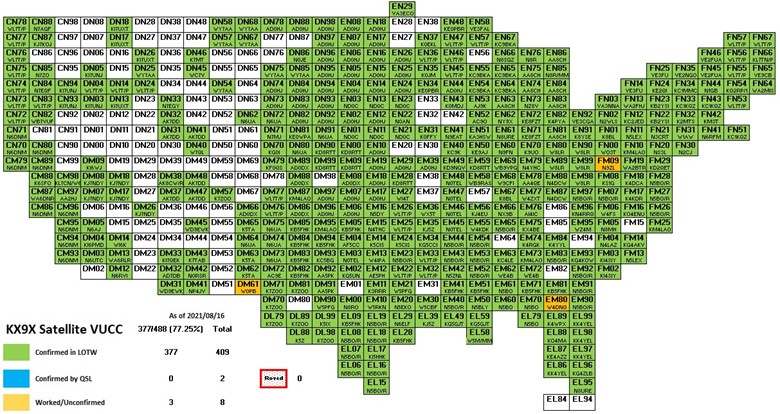Those new to satellite operating are generally thrilled when they finally talk to another person through an object orbiting in space. As the number of contacts starts to grow, many begin to wonder just how many contacts they can make and how far they can communicate. Inevitably, grid squares come into a satellite operator’s consciousness.
Maidenhead Grid Squares are the standard piece of geography used by VHF+ ham radio operators. Each square is 2 degrees of longitude by 1 degree of latitude, or roughly 120 x 60 miles; the actual physical size changes as you get closer to the North or South Poles. They are clumped together in groups of 100 called Grid Fields. Squares are identified by two letters indicating the field, then two numbers indicating a more precise location in that field. As an example, ARRL headquarters is located in grid square FN31. See thismap or the Satmatch.com website for a better understanding.
There are 32,400 grid squares across the globe. With nearly 75% of the Earth covered in water, this leaves roughly 8,100 grid squares worldwide that have land. The ARRL VHF/UHF Century Club Award is for any ham who confirms contact with a certain number of grid squares. The base award requires 100 confirmed grids, with endorsements for additional milestones achieved. While incredibly fun, this is a lifetime award; a ham will never reach the end of the hunt. A similar award, one with a finish line, was needed—an award sufficiently challenging but still obtainable with effort.
The AMSAT GridMaster Award fills this need perfectly. Originally created by the Star Comm group in 2014, the GridMaster Award is awarded to any radio amateur who provides proof of communication with all 488 grid squares in the 48 contiguous United States. It is similar to the ARRL Fred Fish Memorial Award, which is awarded to any ham who confirms contact with the same 488 grids on 6 meters. As of this writing, 32 hams have achieved the GridMaster Award since 2014.

A map of the 488 grids in the 48 contiguous United States. Confirming all 488 will earn you the AMSAT GridMmaster Award (map courtesy of the ARRL)
As with any award, you simply need to get started. Getting on the air as much as possible will certainly build up your confirmed grid totals, and you can do that with either FM satellites, linear satellites, or a combination of the two. After spending some time on the air, you will have accumulated a number of unique grid squares out of the 488 needed. It is not that difficult with this strategy to get to your first 100 grids on satellite, which is about 20% of the way to GridMaster; it also earns you the VUCC Award on satellite.

The AMSAT GridMaster Award is available for hams who confirm contact with all 488 Maidenhead grid squares via satellite. A certificate and plaque are available to those who accomplish this feat. (image courtesy of AMSAT)
After the first 100 grids are under your belt, the hunt will start to get a little tougher. Just like pursuing Worked All States or DXCC on HF, some grids are rarer than others, and your strategy will have to change. While it is certainly possible to work all 488 grids on FM satellites using a dual-band HT and a handheld dual-band Yagi antenna, it’s not the fastest or most efficient way to pursue all 488. You will benefit from getting on the linear satellites if for no other reason than it provides more opportunities for you to get on the air than just using FM birds. You may also find it to your advantage to keep a list of grids you’ve already worked nearby when you’re working a pass so you can maximize your time by focusing on stations that are in a new grid for you. It will also be an advantage, if possible, to set up a satellite base station as opposed to only relying on a portable station. A home station will allow you to get on the air at all hours of the day and night, even if it’s raining or cold.
More than any of those things, however, is intelligence. Just like for DXers on HF, some squares are rarer than others on satellite. Dedicated satellite operators will mount an expedition to a rare grid, or activate multiple grid squares during a trip. Multi-grid activations are known as roves, and hams who go on roves are known as rovers. Knowing when those rare grids are on is invaluable information.
Here are a few tools you can use to help in your pursuit of the GridMaster Award:
- AMSAT’s website includes two pages with information critical to pursuit of the GridMaster Award: The Upcoming Satellite Operations page and the Current Status page. Upcoming Satellite Operations lists grid expeditions and multi-grid roves and is updated regularly. The Current Status page lists which satellites are operational based on crowdsourced reports. Each satellite’s status is listed in three-hour intervals and can help you make the most of your time rather than trying to make contacts on a satellite that is not currently operational.
- Many serious satellite operators are on Twitter, sharing information on their upcoming trips, plus technical tips and suggestions for improving technique. The hive mind on Twitter is a great place for you to connect with other active satellite operators and ask questions. There are also a couple of key accounts to follow: @GridMasterHeat produces a fresh map every week showing the percentage of hams who need every one of the 488 grids for GridMaster. It shows hard data on what the rare grids are and is one of the key ways rovers determine what grids they are going to activate. Another key account is @The Grid Life. Both @The Grid Life and @GridMasterHeat help propagate news of upcoming grid activations to the Twitter satellite community. Of course, you should also follow the @AMSAT Twitter feed to keep up to date on happenings in the satellite world.

GridMasterHeat Map on August 5, 2021: The GridMaster Heat Map shows the percentage of active satellite operators who have confirmed the 488 grids needed for the GridMaster Award. All data is voluntarily submitted by the satellite community. The map is updated every Sunday on Twitter at @GridMasterHeat.
- The AMSAT Twitter Meetup Net on DMR connects satellite operators worldwide in a casual net. Info on upcoming grid activations is presented, but it’s mainly just a fun place to hang out and get to know other satellite operators. It meets every Wednesday evening at 9 p.m. CDT (0200Z Thursdays) on BrandMeister Talkgroup #98006 and Yaesu System Fusion (YSF) Reflector #11689. Don’t have DMR? You can listen to the net on Echolink on the node *AMSAT* (#101377).
- The GridMaster Map by Robert Bankston, Jr., KE4AL; Chris Tabor, K7TAB; and Tanner Jones, W9TWJ is an Excel spreadsheet that can help you keep track of the 488 grids you need for the GridMaster Award by color-coding the grids on a map by status: Confirmed via Logbook of the World (LOTW), Confirmed by QSL Card, Worked but Not Confirmed, and Not Worked. You can manually cut and paste your LOTW data directly into the spreadsheet and it will populate the map accordingly. It’s a very handy tool to help you track your progress.
- ARRL Logbook of the World (LOTW) is the most efficient way to get your QSLs for both GridMaster and ARRL’s VUCC Award, and it’s free to use by all hams (it does cost money to apply for an ARRL award, however). Most rovers and serious satellite operators use LOTW. It saves time and money compared to sending out paper QSLs with a self-addressed stamped envelope (SASE). As of this writing, confirming all 488 needed grids by QSL card, with an SASE included, would cost $536.80 and take up a lot of time filling out those QSLs and waiting for a reply. It costs a fraction of that to use LOTW and confirmations come much faster. Check out AMSAT’s page on LOTW for satellite operators to see how easy it is.
The AMSAT GridMaster Award offers satellite operators a challenging but achievable award to demonstrate their skills on the birds. It can be realized with even a small, portable satellite station. How long it takes will depend entirely on your operating time. I’ve been pursuing it seriously for just over two years and I have 411 of the 488 needed grids confirmed, or 77%.

My GridMaster Award data as of August 16, 2021, as displayed in the GridMaster Map by KE4AL, K7TAB, and W9TWJ. This Excel spreadsheet provides a clean, easy-to-use form to keep track of grids worked and confirmed toward your GridMaster Award.
I know a few satellite operators who completed it in just under two years. It is a significant operating achievement in ham radio, but by no means impossible. And don’t forget, you can pursue this activity even as a Technician class licensee! Give the GridMaster Award some thought. I’ll wager you’ll have a great time pursuing it.
Have a question about the GridMaster Award or satellite operating in general? Drop me a line [email: kx9x@yahoo.com] or follow me on Twitter; I’m happy to help.

